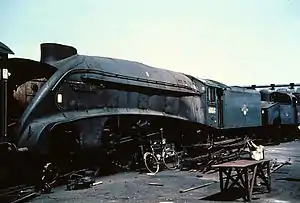| Silver Link | |||||||||||||||||||||||||||
|---|---|---|---|---|---|---|---|---|---|---|---|---|---|---|---|---|---|---|---|---|---|---|---|---|---|---|---|
 Silver Link at Doncaster Works in March 1963, shortly before it was broken up for scrap | |||||||||||||||||||||||||||
| |||||||||||||||||||||||||||
| |||||||||||||||||||||||||||
| |||||||||||||||||||||||||||
| |||||||||||||||||||||||||||
LNER Class A4 2509 Silver Link was a 4-6-2 "Pacific" built in 1935 for the London and North Eastern Railway. It was the first of the Streamlined Class A4s built to haul express passenger trains on the East Coast Main Line (ECML). 2509 was one of four A4s to be painted in a special silver livery to pull a new train called the Silver Jubilee.
History
Silver Link entered service with a demonstration journey departing from King's Cross Station on 27 September 1935. 2509 reached a top speed of 112.5 mph (181.1 km/h), breaking all previous UK records.[1] The record provoked the LNER and their chief rival the London, Midland and Scottish Railway (LMS) into a highly competitive speed war, each attempting to outdo the other by building ever faster locomotives. The main protagonists were Sir Nigel Gresley, LNER's chief mechanical engineer, and his counterpart at LMS, Sir William Stanier.
Naming
Silver Link was named after a reference to love in Sir Walter Scott's poem The Lay of the Last Minstrel, which reads:[2]
True love's the gift which God has given
To man alone beneath the heaven;
It is not fantasy's hot fire,
Whose wishes, soon as granted, fly;
It liveth not in fierce desire,
With dead desire it doth not die;
It is the secret sympathy,
The silver link, the silken tie,
Which heart to heart, and mind to mind,
In body and in soul can bind.
The engine was "officially named" (using its real name) in the opening scene of the 1937 comedy film Oh, Mr Porter!.
Scrapping and legacy
Allocated to Kings Cross shed, it was withdrawn from service on 29 December 1962 when the East Coast Main Line express services were taken over by Class 55 'Deltic' diesel locomotives. It was not preserved after withdrawal and was broken up for scrap at Doncaster Works on 7 September 1963, on the same site where it had been built nearly twenty eight years earlier.[3][4] There was an attempt by Sir Billy Butlin to save the locomotive, but it was unsuccessful.[5]
Two examples of the Silver Link nameplate are on display at the National Railway Museum, York, UK.[6]
The Silverlink area of North Tyneside is named after the locomotive; the name of the area was taken after another A4 locomotive.
Former classmate LNER 4464 Bittern was repainted in 1991 and disguised as 2509 Silver Link. It was moved around on static display in the early to mid 1990s.[7] It was eventually reverted to its real identity as 4464 post 1995 as the locomotive was being dismantled for eventual operation
References
- ↑ Nock, O. S. (1972) [1971]. Speed Records on Britain's Railways: a chronicle of the steam era. The David & Charles series. London: Pan. pp. 149–50. ISBN 0-330-23365-3.
- ↑ Bartleby.com.
- ↑ Boddy, M. G.; Neve, E.; Yeadon, W. B. (April 1973). Fry, E. V. (ed.). Locomotives of the L.N.E.R., part 2A: Tender Engines - Classes A1 to A10. Kenilworth: RCTS. p. 134. ISBN 0-901115-25-8.
- ↑ "BRITISH Steam Railway Train Loco Photo Prints - FOR SALE » View image". railwayphotoprints.co.uk. Archived from the original on 21 April 2013. Retrieved 6 June 2022.
- ↑ Scott, Peter (February 2001). A History of the Butlin's Railways: The Story of Billy Butlin's Amusement Park and Holiday Camp Miniature Railways, Including Other Associated Railways and Transport Systems. Issue 2 of Minor Railway Histories Series. p. 130. ISBN 1902368096. Retrieved 9 November 2020.
- ↑ National Railway Museum, object number: 1975-7609
- ↑ "Silverlink Business Park - Great train inspired the park name". The Journal. Newcastle upon Tyne. 27 March 1991. p. 24.